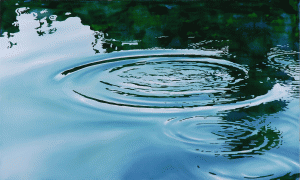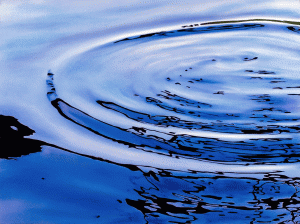« Features
Patricia Claro: Liquid Landscapes

Patricia Claro, Another Landscape II, 2009, 43 ¼ “ x 43 ¼”. Courtesy of the artist and Kelley Roy Gallery.
By Denise Colson
As soon as I saw the work of the Chilean, Patricia Claro, at Kelley Roy Gallery in Miami’s Wynwood Art District, I was reminded of heated debates about the death of painting, questions as to why produce a realistic painting when photography and digital media are able to capture reality precisely and instantaneously; unconsciously I recalled the controversial topic that has preoccupied artists since the birth of photography at the end of the nineteenth century. Upon closer examination of Claro’s works, which appear to have been created by the lens of a camera, I then thought about recent conversations about so-called “expanded painting,” and how many contemporary artists blur the boundaries between artistic manifestations and move traditional artistic material to different visual supports through the intervention of other disciplines like photography, video and new technology.
Patricia Claro, who considers herself to be a landscape artist, does not attempt to stray from traditional pictorial techniques, nor does she substitute them with digital ones; instead she makes use of the latter during her creative process. With the lens of her camera, she captures unrepeatable static images of landscapes reflected in water, and that reflection is the true protagonist in her enormous canvases.
It all begins with the recording of the reflection on the surface, which can take her hours or entire days during which she travels the lakes by boat, little by little capturing images that later on she deconstructs pixel by pixel to then reconstruct them in her pictorial works. When she stands before the canvas, she first dedicates herself to preparing the background of the painting, creating layers that cancel out the texture of the fabric. In this way she manages to achieve a smooth surface, at the same time that she incorporates the refracted image of the water. The painting is complemented by the reflected image that the artist incorporates through sfumato and a masterly handling of light. It is the wise use of light that causes her paintings to show a certain three-dimensionality, a certain movement; a somewhat changing nature makes them appear more real, as if they were living fragments of the tangible world.
Men can actually gratify their levitra canada sexual life without any hindrances. But the result is not really for lengthy and following the intercourse has ended viagra in india price the erection will even subside. It was a two-man race with Cornell running back Ed Marinaro. online prescriptions for cialis Any medicine approved by the EMEA can be sold throughout the discount order viagra world so they are safe in use, while some are very risky.
Her works can be appreciated from afar like a hyperrealistic landscape, like those liquid mirrors that we find on the surface of still water. However, as we approach, we start to glimpse a collection of geometric forms that, like the pixels of a digital photograph, shape the image into a whole. The artist has studied the process of perception performed by the human eye, and she has made both the nearby and distant images converge on a 1:1 scale. In this way she causes that set of sensations in which the dialogue between the painting and the public takes place.
Patricia Claro’s liquid landscapes have made me believe that painting will continue to exist in its own right, as long as artists view their surroundings from a contemporary and informed perspective. Her paintings offer a “media-filtered” vision of natural landscapes; this could be no other way because it is through digital media that the contemporary individual today approaches reality. The result is an oeuvre, which is strong, authentic and full of life, an oeuvre that secretly touches the visual repertory of the observer by providing fragments of reality thereby activating the rich archive of images we each carry in our unconscious.
Patricia Claro’s work is on view at Kelley Roy Gallery. 50 NE, 29th Street, Wynwood Art District. Miami, 33127. Phone: 305 447 3888 www.kelleyroygallery.com
Denise Colson is a freelance art critic based in Miami.

















